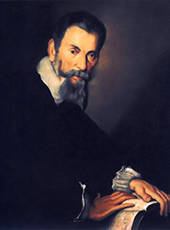

Claudio Monteverdi
Il Combattimento di Tancredi e Clorinda
Short instrumentation: 0 0 0 0 - 0 1 0 0 - perc, hp, acc, vln, vln, vc, cb
Duration: 25'
Bearbeitung: Klaus Simon
Text von: Torquato Tasso
Solos:
soprano
mezzo-soprano
baritone
Roles:
Clorinda (soprano) Testo (mezzo-soprano) Tancredi (baritone)
Instrumentation details:
trumpet
percussion
harp
accordion
1st violin
2nd violin
violoncello
double bass
Monteverdi - Il Combattimento di Tancredi e Clorinda for chamber ensemble
Sample pages
Work introduction
Thoughts on my new arrangement of Claudio Monteverdi’s Il Combattimento di Tancredi e Clorinda, created as a meaningful coupling with Luke Bedford’s opera Through his Teeth (2013/14).
Monteverdi’s music – especially his music for the stage – was played prior to the advent of historical performance practice, always in performing versions expressly prepared for the occasions. Thus, the Monteverdi Complete Edition (published between 1926 and 1942) by the Italian composer and musicologist Gian Francesco Malipiero, however highly meritorious, must be defined as a child of its time, since it appears historically “incorrect;” dynamic indications, phrasing marks, etc. are rife in his edition, all of which contradict the originals. Nevertheless, it contributed decisively to Monteverdi’s rediscovery, and it is still in widespread use today.
No less a musical figure than Luciano Berio arranged Monteverdi’s Combattimento in a similar manner in 1966, scoring it for soprano, tenor, baritone, harpsichord and strings (three violas, violoncello and contrabass). Published by Universal Edition, it is still performed today by such ensembles as the Munich Philharmonic and the Berlin Radio Symphony Orchestra.
Therefore, the question inevitably arises as to whether it is reprehensible or even hubristic to produce yet another version which, once again, is not historical: why, when there are top-class Baroque orchestras everywhere which can play Monteverdi historically “correctly?”
In the spring of 2015, when stage-director Hendrik Müller and I decided to find a piece to complement Luke Bedford’s short opera (ca. 55 min.) Through his Teeth, we ended up selecting Monteverdi’s Combattimento; we liked its stylistic contrast along with the simultaneous contextual parallels. As with Through his Teeth, Combattimento has three singers whom we could adopt quasi identically. In the Monteverdi, the roles of both Testo and Tancredi are sung by one tenor, although the two parts can very well be performed by a mezzo-soprano and/or a baritone, since the tessitura is unusually high.
We assigned the role of Testo to the mezzo-soprano who, in Bedford’s opera, plays the triple role of Interviewer/Sister/S, and we adopted our performer of R (a baritone) from Tancredi. Clorinda remains a soprano, as in the original, performed by the singer of A.
Our ambition was to manage to the extent possible with the eight-man instrumental group of Through his Teeth when I was arranging the Monteverdi for our purposes; thus, for the first time in its 20-year history, the Holst Sinfonietta (the ensemble of the premiere production – they actually perform music of the 20th and 21st centuries) was going to play old music. It was an unusual task for me; normally, I prefer to arrange Mahler or Berg.
Now, what has been changed in my new version of Combattimento? The clarinet, which plays a large part in Bedford, was not used; it suggests anachronism with Monteverdi. Instead, I added a second violin, making it possible to have a four-part string group, as Monteverdi intended. Bedford does not use a viola, which means that the violoncello and the contrabass must occasionally play higher than usual; the cello in particular often plays in the alto range. A harp, accordion, trumpet and percussion are new; I used them very deliberately in terms of the dramaturgy.
The harp is used as the main continuo instrument, instead of a lute or harpsichord. It also has small solo passages when Clorinda sings; therefore, altogether it symbolises the Feminine in the piece – what could be better suited than the harp, which has always been used as a very feminine instrument? The accordion plays only when Tancredi sings, i.e. in contrast to the harp, it is the “masculine” continuo instrument.
The trumpet and percussion (tambourine, tom-tom and whip) support dancing, celebratory and bellicose scenes; they were composed as an additional commenting layer. As a result, Monteverdi’s orchestra is larger in my new version, with a wider tonal palette compared to the original and to Berio’s arrangement; my concern was with variety, colourfulness and theatrical effectiveness.
Nevertheless, it is a testimonial to Monteverdi’s genius; the three singers’ music is 100% Monteverdi, the spirit of the early Baroque is not broken but merely dramaturgically reinforced – nothing more and nothing less.
Klaus Simon, July 2016
